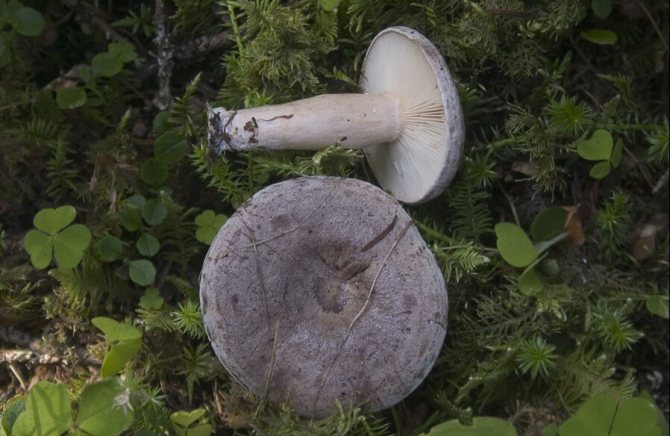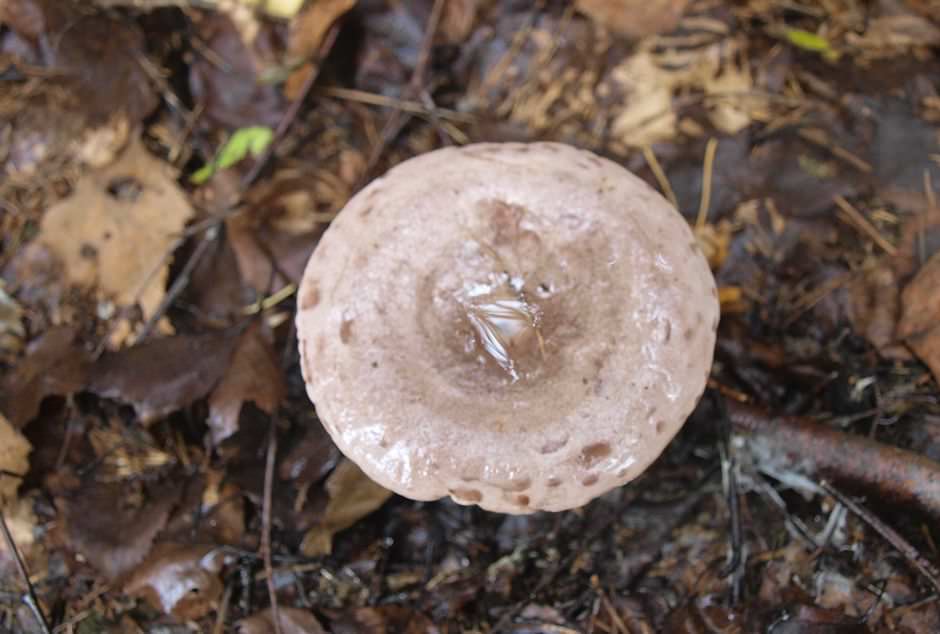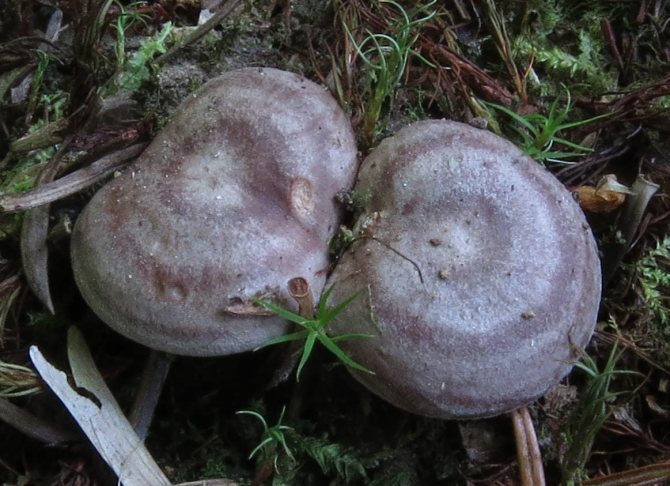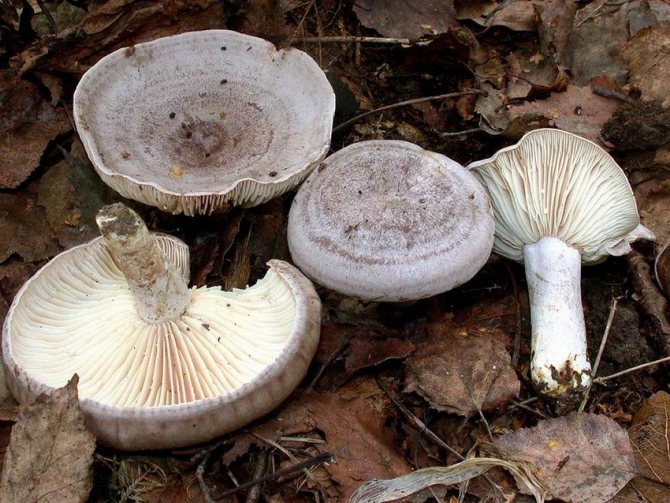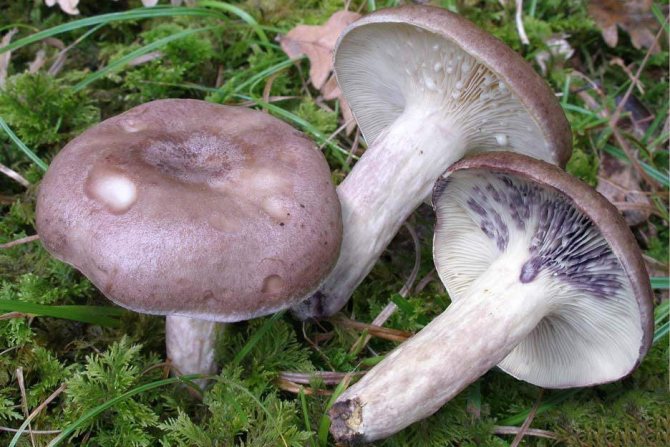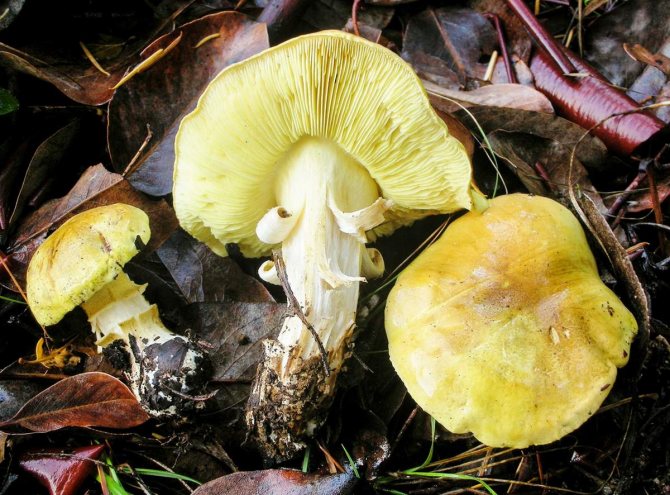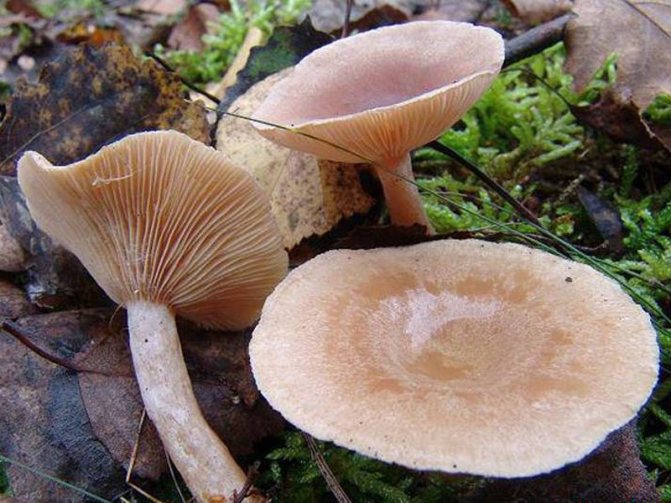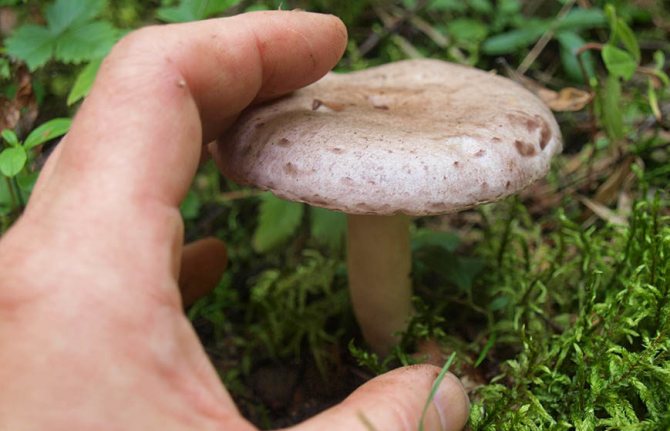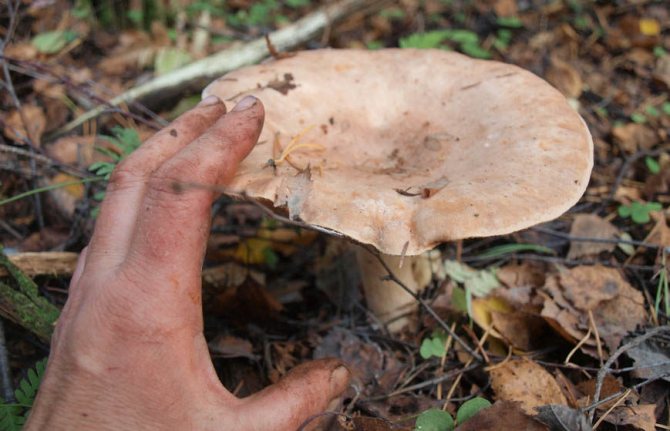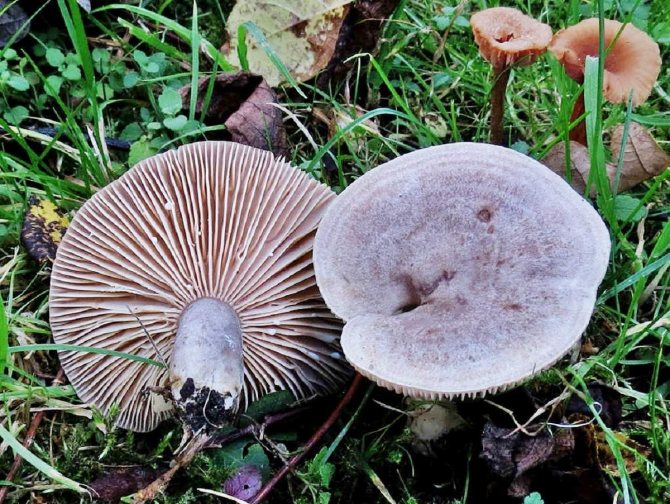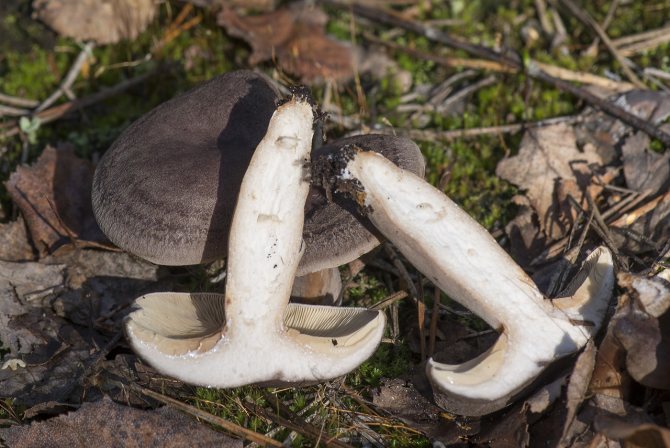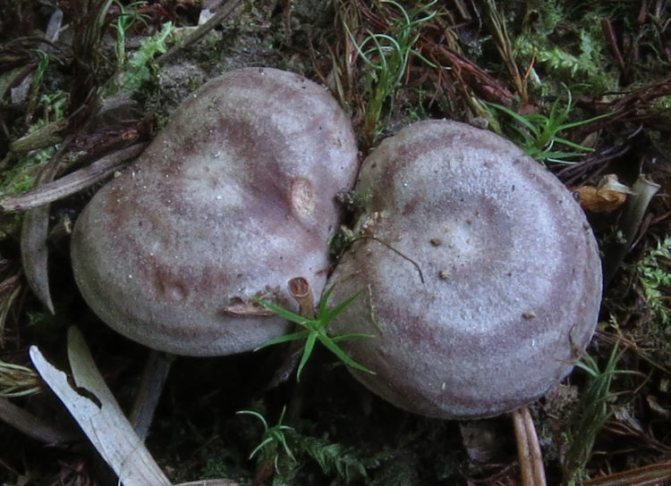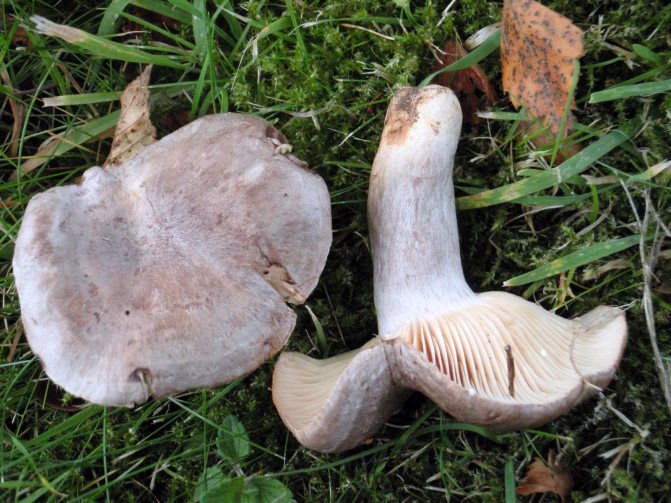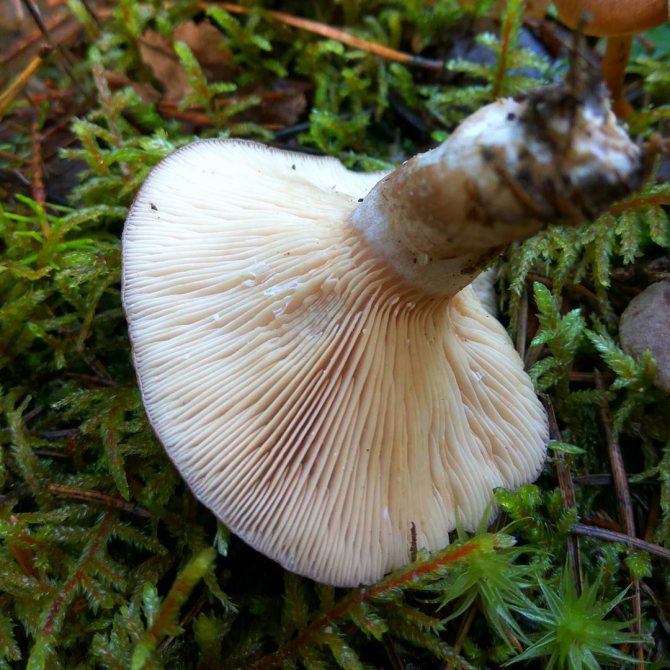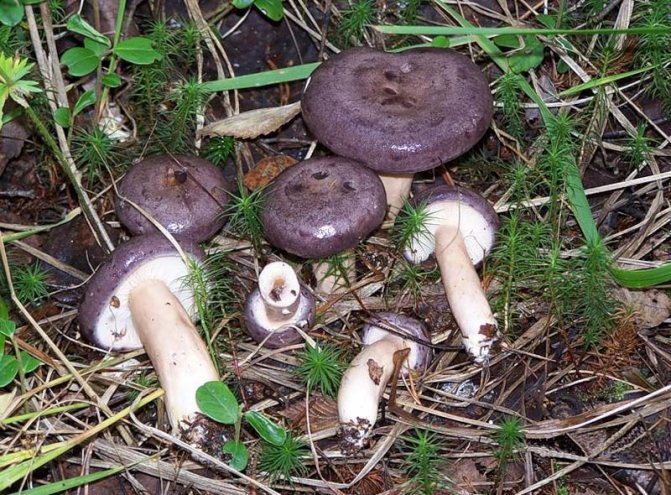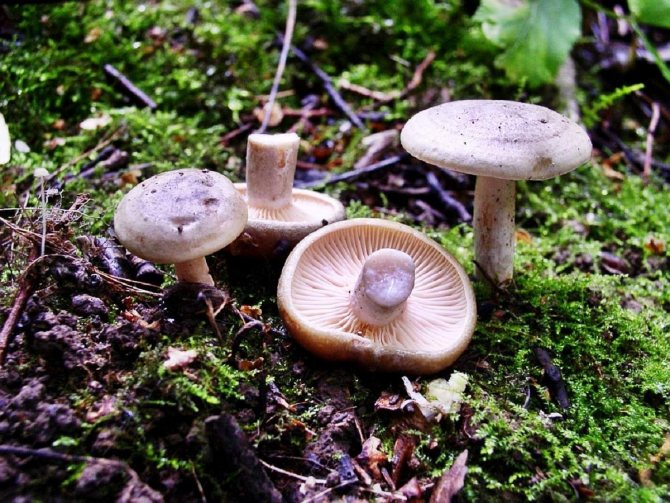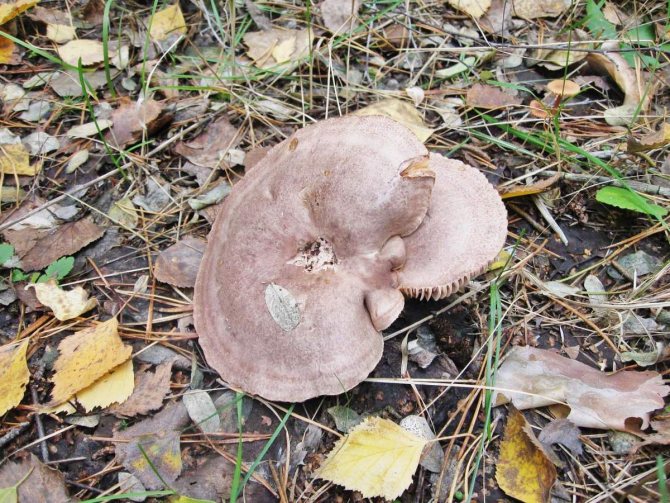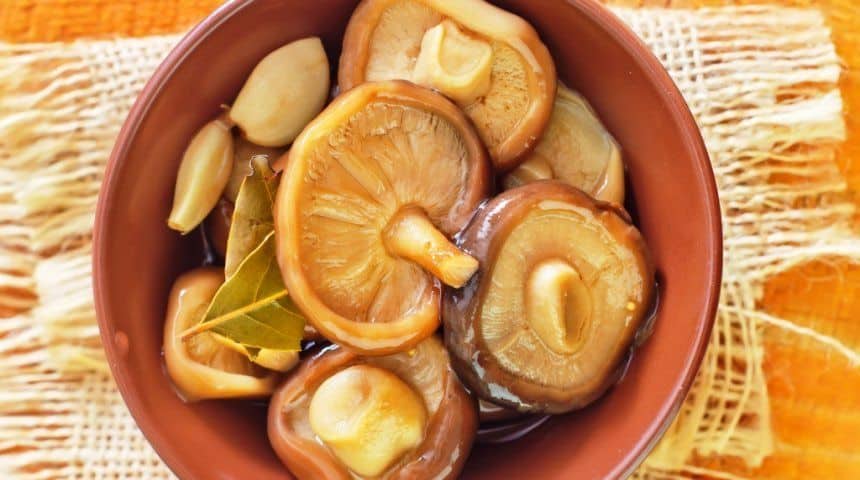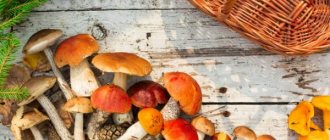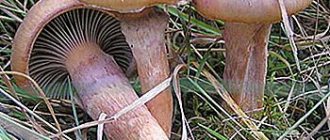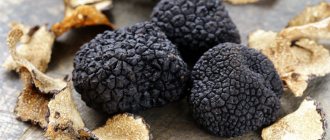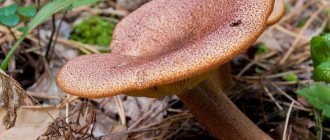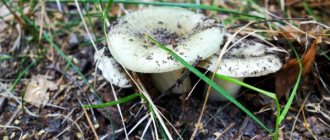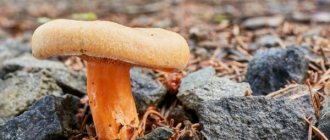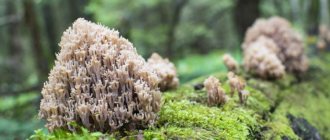One of the most widespread types of mushrooms in Russia is gray-haired. Experienced mushroom pickers never pass by these inconspicuous small mushrooms, as they are considered a great delicacy if prepared correctly.
This species is conditionally edible, because it contains caustic milk juice, which can have a toxic effect on the human body. Serushki have an unattractive appearance and a faded grayish cap, therefore they often go unnoticed.
Characteristic features of the variety
Mushrooms belong to the genus Mlechnik and the Syroezhkovy family. In order not to leave an inconspicuous mushroom unnoticed and to distinguish it from others, it is necessary to pay attention to its morphological features. Photos and descriptions of serushki mushrooms are presented below.
Other names for serushki
Serushki have a large number of other names. Among them:
- lilac breast;
- seruha or seryanka;
- gray nesting house;
- gray or gray-lilac milky;
- plantain or plantain;
- greenfinch;
- path;
- gray row;
- bitter.
The gray row differs from other types of lactic acid by rarely located yellow plates and milk juice, which does not change its color in the air.
Appearance and photos
It is very important to remember how the mushroom looks, then it will not be difficult to distinguish it from other species even for inexperienced and novice mushroom pickers. The appearance corresponds to the name of the serushki, since most often the mushroom cap has a grayish color.
However, sometimes there are specimens with a faint pink, pale purple or bright brown color. The fruit body of the serushki reaches small sizes, and also very often merges with the ground and leaves.
Morphology
Zelenushki have the following specific features:
- The mushroom cap can be up to 10 cm in diameter. In the center of the cap there is a small tubercle, which smoothly turns into a funnel-shaped, the edges are convex, bent in the middle, wavy. The surface relief includes concentric and flat parts. The color can vary. The lamellar part is represented by sparsely arranged sinuous plates, initially straight and adherent to the pedicle. Light yellow color predominates.
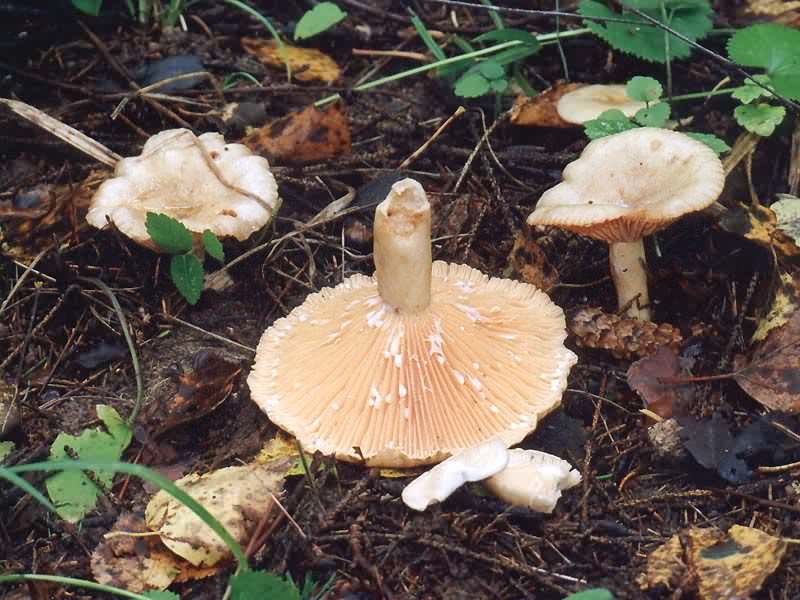
Serushka Lactarius flexuosus
- The spores are small, spherical and yellow in color, with an ornament. The spore powder is also yellow.
- The leg is massive, up to 2 cm wide and 8-10 cm high. It is dense in consistency, there is a cavity inside. It is cylindrical in shape, with longitudinal grooves on the surface. The color is the same as the color of the hat or is slightly lighter.
- The pulp is dense in consistency, soft, has a pleasant aroma, looks like fruit from a distance.
- The juice. When cut, milk juice of white color and with a pungent taste is released from the fruiting body. It does not oxidize in air and does not change color.
Place of distribution
Most often found in mixed or deciduous forests. The most comfortable conditions for growth are observed in thickets of birches or aspens, since the area is well lit there, and the upper layers of the soil are always warmed up. Lilac milk mushrooms also love swampy places, therefore, after heavy autumn rains, their increased growth is observed.
The peak yield occurs in early July and lasts until the end of autumn. This variety grows in virtually all regions.The mushroom can be found in all countries of Europe and Asia. They are especially common in Siberia and the northern part of Russia. The most comfortable climate is considered to be temperate. They grow mainly in groups.
Eating
When picking mushrooms, it is imperative to be able to distinguish an edible from a poisonous species. Greenfinches themselves do not pose a threat to human life and belong to the conditionally edible type due to the presence of caustic white juice inside.
Description of mushrooms
Judging by some of the names, we can conclude that the gray-headed mushrooms have gray caps and are found in nature as mushrooms.


Why do they still refer to milk mushrooms? Because they also contain milky juice.
By its structure, the mushroom is most of all similar to a smoothie, and not to a lump. Many novice mushroom pickers confuse the seruha with the smoothie, but this is not important, because both are edible. The description of the traveler's mushroom refers to the fact that centric circles are visible on its cap, for this reason they can still be confused with waves. If you look closely, you can see that the earwife has gray or purple waveswhile others are dark pink.
Traveler mushrooms have lamellar spores, the cap itself is smooth, and its edges are slightly rounded. On young mushrooms, the cap is slightly convex, but in mature ones it looks more like a funnel with a tubercle in the center. Usually, the diameter of the cap does not exceed 10-12 cm, but if the summer is rainy, then you can find a mushroom with a cap of 20 cm in diameter.
The traveler's leg is of medium length, cylindrical in shape and with fine grooves along its entire length. Mature earrings have a hollow stem, the same color as the cap, or slightly lighter in color. Due to the fact that the mushroom has a hollow leg, it is also called a nest box. Seruha has a dense white flesh with a fruity or slightly resinous odor.
The traveler has a milky sap, which has a white color and a pungent odor. The composition of the milk juice contains an antibiotic that helps to stop the growth of Staphylococcus aureus bacteria, and in addition fights some microorganisms.
Beneficial features
Mushrooms have a unique chemical composition. When consumed regularly, this contributes to:
- nutrition of the brain;
- increasing the immune properties of the body;
- strengthening of blood vessels;
- removal of heavy metals and salts.
Traditional healers use these mushrooms to treat stomach ailments and various skin problems.
It is worth notingthat, despite the sound and frightening name, serushki are very useful for the body. In addition to them, there are one more green mushrooms, which are distinguished by a green cap that does not change its color even after cooking. Seruha and greenback mushrooms sound quiet, but they have a rich vitamin composition that benefits the body.
Growing places
Most often, the traveler can be found in groves where aspen or birch trees grow, but they can also grow in mixed forests, on the edges, along paths or meadows. Gray mushrooms and greenfinches, as well as milk mushrooms, grow in heaps in lighted places. Why was he called a traveler? Because most often he is met by those mushroom pickers who hunt quietly.
In our country, it is found in regions with a temperate climate. Fruiting begins in mid-summer., taking into account the fact that there will be enough moisture for it. This period lasts until the first frost.
If in the autumn there is white powder around the pile of serukha, then you should not collect it. These are disputes and their presence suggests that they are already overripe. Most mushroom pickers prefer young specimens for this reason.
Rules and places of collection
Experienced mushroom pickers advise focusing on low-lying areas with a large amount of moisture, as well as in places where a large number of birches grow. Lilac milk mushrooms are harvested from mid-summer to late autumn.It is necessary to collect only young specimens, since the old ones accumulate over time all the harmful substances of the environment.
To collect with you, you need to take a sharp knife and a basket. Serushki often hide in the leaves and merge with the ground, especially in the shade, so you need to look carefully for them. Found plantains are cut at the root and thoroughly cleaned of leaves, dust and earth. The collected mushrooms are placed in a basket with their caps down in order for the plantains to be better stored.
Experts recommend going to collect purple milk mushrooms early in the morning, while they have not yet warmed up under the sun and can be stored for a long time. After collection and before use, each purple lump must be carefully inspected to ensure that it is indeed a pear. After that, the selected ones are soaked in water for several hours and only then they start cooking.
A simple recipe for caviar for the winter
There are many recipes for cooking dishes from travelers, one of which is spicy caviar for the winter.
Ingredients:
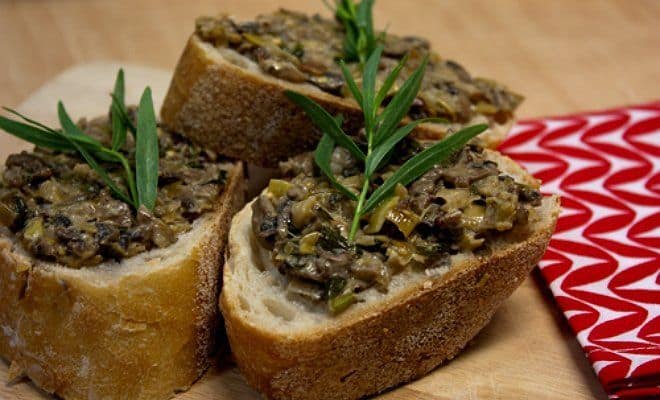

- serushki - 1 kg.;
- carrots - 1 pc.;
- onions - 2 pcs.;
- garlic - 6 cloves;
- vinegar - 1 tbsp. l .;
- salt - 30 g;
- vegetable oil - 50 ml.;
- bay leaf - 2 pcs.;
- black pepper to taste.
Serushki caviar for the winter is prepared as follows:
- Soak the mushrooms and boil for thirty minutes in water with the addition of salt. Repeat cooking again.
- Next, the boulders need to be transferred to a colander and allowed to drain off the water.
- Then pass them through a meat grinder.
- Peel the vegetables. The carrots should be grated on a coarse grater, the onion should be cut into cubes.
- Darken the carrots and onions a little in a frying pan, and then also pass through a meat grinder.
- Stir all the ingredients, add salt and spices and simmer over low heat, covered with a lid for another 15 - 20 minutes.
- Pour in the vinegar. Stir and transfer to sterilized, clean jars. Twist.
Differences between edible serushki and poisonous counterparts
Very often, real serushki can be confused with false or poisonous ones, which can harm human health. Most of all, representatives of the rowing species look like serushki. Poisonous ryadovki include white, soapy, sulfur, mouse and tiger. In order not to be poisoned by poisonous rows, you need to know some of the features of their appearance:
- Young white ryadovka has a white or milky color, which acquires a dark spot with age. Leopard is similar to white, as the surface of its cap is covered with large brown spots. Rows, the hats of which are very similar in shape to serushki, have a dirty yellow color and are also prohibited from eating them.
What poisonous mushrooms can be confused with
The most dangerous and poisonous mushroom that can be confused with a gray-haired mushroom is a pale toadstool.
The main differences are the following characteristics:
- The shape of the apex is at first hemispherical, then flat. It has smooth edges, and its surface is covered with fibers.
- The hat can be olive, green or gray.
- The leg grows, as if from a "pouch", has a fringed ring closer to the cap.


Mushroom pickers should take a close look at this type of deadly poisonous mushroom, since the fringed ring on the leg of the pale toadstool disappears with age. And it is one of the main differences from edible mushrooms.
Useful properties of earrings and restrictions on use
This variety has a large number of useful properties due to its composition. So, serushki contain a large amount of amino acids, vitamins, minerals. Potassium, which is also a part, normalizes the work of the heart muscle and blood vessels, restores acid, alkaline, water-salt and electrolyte balance, the metabolism of proteins and carbohydrates.
B vitamins prevent the development of gallstone disease, obesity and disorders of the nervous system.Phosphorus contributes to the growth of the musculoskeletal system, and is also responsible for the transport function in the body.
In folk medicine, infusions and decoctions are used to treat diabetes mellitus, cancer, depression and nervous disorders, hypertension, rheumatism, arrhythmia and osteoporosis. Greens are characterized by antibacterial, antimicrobial and immunostimulating effects.
Our ancestors often used serushki to treat stomach ailments and even added them to cholera medicine. Also, this type is often used for dietary nutrition, which is associated with their low calorie content and high content of nutrients in the required proportions. Due to their high content of polysaccharides, they are often used as an immunostimulant.
Salting at home
Most often, at home, salted salmon are used for salting. Before cooking, the collected mushrooms must be thoroughly washed and left for several hours in warm water with salt to remove the bitterness and toxins. It is important to remember that if 20-30% of the fruiting body is spoiled, then such a mushroom should not be eaten.
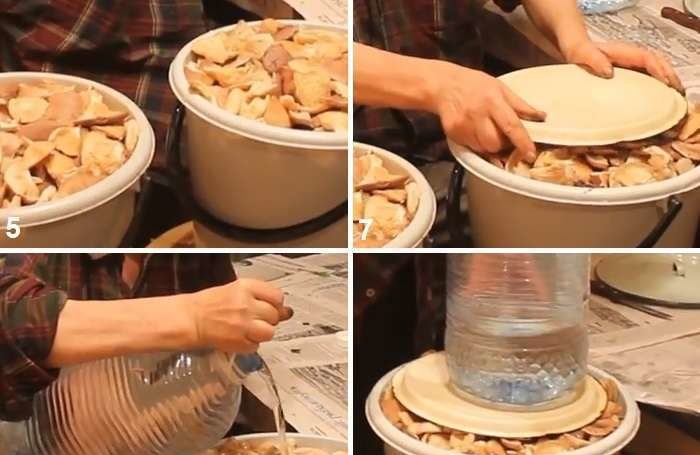

For salting, you need to cook 2-3 kg of mushrooms, salt, peppercorns and garlic. For aroma, bay leaves, dill, currant and horseradish twigs are used. Mushrooms are soaked, then dried and peeled with a sharp knife. Then they are placed in oak barrels. Lay out all the ingredients in layers, not forgetting to salt, after which they cover everything with a lid and put a press on top. The barrel is placed in a cold, dark place. The mushrooms are ready after one and a half to two months.
Recipes
It is better to salt pig mushrooms hot with frying (we do not recommend salting pigs in a cold way).
For blanks, use only coarsely ground table salt without iodine.
Traditional salting recipe
This is a simple recipe, but only in terms of the amount of ingredients - you need a minimum of them. But with mushrooms you will have to work hard, since they require serious preliminary preparation: soaking and triple boiling. Using this method, you can salt pigs for the winter in large quantities.
Servings / Volume: 2.5-3 l
Ingredients:
- fresh pigs - 3 kg;
- rock salt - 150 g;
- dill umbrellas - 8-10 pcs.;
- black currant leaves - 10 pcs.;
- garlic - 8-10 cloves;
- black peppercorns - 10-15 pcs.
Preparation:
- Rinse the pigs, cut off suspicious fragments, cut medium-sized mushrooms into 2 parts.
- Put the mushrooms in a container / basin, cover with cold water and leave for 16-18 hours. Change the water 4-5 times.
- Drain the liquid, pour the soaked pigs with salted water, put on fire, wait for a boil and boil for 10 minutes.
- Drain the first water and pour the mushrooms with a new portion of salted water, but this time the cooking will take 30 minutes from the moment of boiling.
- Repeat the process again. The third time, the mushrooms are boiled for 45 minutes.
- Rinse the dill and blackcurrant leaves, cut the peeled garlic into slices.
- Put dill umbrellas and currant leaves on the bottom of sterilized jars.
- Throw the mushrooms in a sieve or colander and let the water drain.
- Arrange the pigs in jars, sprinkle with salt, pepper and garlic plates in layers.
- Boil clean water, pour the jars to the very top.
- Put oppression in each of them: an ordinary glass filled with water will do.
- Banks stand indoors at room temperature until they cool completely, and then they are sent to a cold place - a cellar or refrigerator.
- After 45 days of salting, the pigs are ready.
Bon Appetit!
Salting recipe: hot method with frying
It is somewhat laborious, but the pigs after such processing can be eaten without fear for their health. In addition, frying the taste of mushrooms becomes more intense, so salting in this way is very popular.
Important! The required amount of vegetable oil in this recipe depends on the number and size of mushrooms and is different in each case.
Servings / Volume: 3 l
Ingredients:
- fresh pigs - 4 kg;
- table salt - 8 tbsp. l .;
- garlic - 3-4 medium-sized heads;
- vegetable oil - a sufficient amount for frying;
- bay leaf - 10-15 pcs.;
- black peppercorns - 10 pcs.;
- allspice peas - 10 pcs.
Preparation:
- Rinse young pigs thoroughly and cover with cold water for 48 hours. Change the water at least 4 times a day.
- After 2 days, drain the water, rinse the mushrooms.
- Pour the pigs in a saucepan with salted water and cook them after boiling for about an hour and a half. Remember to skim off the lather.
- Drain the water, repeat the process. Cooking time for the second time is 45 minutes.
- Throw the mushrooms in a colander, let the excess liquid drain.
- Rinse the seasonings, peel and grind the garlic into a gruel.
- Place the pigs in a sufficiently deep frying pan, pour oil so that it covers them completely.
- Add spices and salt, mix everything.
- Fry the mixture for about 45 minutes, stirring occasionally.
- Put the ready mushrooms in clean, dry, sterilized jars, close with nylon lids.
- Leave in the room until it cools completely, then transfer to the cellar or refrigerate.
- The first sample can be taken in a day.
Enjoy the taste, bon appetit!
What else is it called?
Serushki is just one of the many names. This mushroom has more than a dozen of them. In Russia, depending on the region, these mushrooms are called:
The names reflect all the remarkable properties of the mushroom - its taste, color, favorite places of growth, the release of milky juice.
Features of serushki
The gray milky is perfectly camouflaged in the grass and needles. This wetland lover is easy to spot. And not so much in appearance - although he has bright signs, as in drops of bitter juice protruding from the cut.
The path is beautiful in its own way. He not only has an original taste, but an exquisite look. Description of species characteristics:
- Hat. Color - gray-lilac. May have a pinkish, purple and brown-leaden tint. The hat is smooth to the touch, slippery after rain. Top - concentric circles. The shape is funnel-shaped. In small mushrooms, it is convex. Hat edges are uneven, lowered or bent inward. The diameter of the cap of an adult mushroom is 5-10 cm.
- Plates. They are distinguished by a rare location. Color - pale yellow, beige.
- Disputes. Yellow color.
- Leg. Has a cylindrical shape. Bloated or narrowed at the base. In adult mushrooms, it is hollow. The color will repeat the color of the plates or cap. Reaches 2 cm in width and 8 cm in length.
- Pulp... Dense, elastic. Has a fruity aroma. White color. At the break, milky juice is released - it has an extremely bitter taste. The mushroom does not change color on the cut.
Where and when does it grow?
Serushki are regulars in deciduous and mixed forests. Distributed almost throughout the territory of Russia. Preference is given to the northern regions and Siberia. It is also found in the Urals and the Far East. Grow well on moist soils - loamy and sandy loam. They love birch and aspen forests, especially lowland ones.
It is better to go to the well-lit deciduous forests - birch and aspen forests for the gray-haired ones. They love moisture, so it's best to look for them after rain. The picking season starts in July and lasts until September. In a drought, there is no need to count on a harvest of paths. What assemblers need to know:
- The mushroom is fruitful - it grows in groups. But it can grow alone. Favorite growing places are forest edges and paths.
- The collection period is from early summer to October.
- The color of the cap varies from gray to yellowish gray and ocher.
In the video, seasoned mushroom pickers are looking for earrings. In forest conditions, they will talk about the peculiarities of the growth and harvesting of these mushrooms:
Travelers are also rich in selenium, calcium, magnesium, potassium, zinc, phosphorus, iron, copper and manganese. Serushki are valued for their rich set of vitamins, minerals and amino acids. These mushrooms contain useful elements in the most favorable proportions. Scientists say this is the most winning combination. Perhaps that is why paths were so actively used in traditional medicine. With its help, many diseases were treated - from lesions of the skin to consumption and cholera.
Lilac milk mushrooms strengthen the immune system and blood vessels, nourish the brain, cleanse the body of heavy metal salts.
Harm of serushki
Medicinal decoctions from serushki should be carefully taken by people with gastrointestinal diseases, pregnant women, lactating women, allergy sufferers. They are also not advised to overuse any mushroom dishes. Serushki abuse can provoke:
- Allergic reaction. It can manifest itself in constipation, digestive disorders and even abscesses on the gastric mucosa.
- Poisoning. There is a lot of chitin in the mushroom. Overeating can cause nausea, vomiting, diarrhea, chills, bloating, dizziness, and other symptoms of an eating disorder.
- Inflammation of the duodenum.
- Frequent urge to urinate.
- Erosion of the walls of the stomach by bioactive components.
Components in serushi are capable of destroying muscle cells and causing kidney failure.
Despite the abundance of useful properties, you need to be careful with the serushki. They have elements that thin the blood and prevent it from clotting. Paths are categorically contraindicated in bacterial vaginosis and dropsy.
Serushki, belong to the russula family, a genus of milky. For bitterness, mushrooms are assigned to the conditionally edible group of the third food category. The pout is quite tasty when salted, but first you need to soak it thoroughly so that the bitterness goes away. Soaking takes several days. Bitter juice saves serushki from worms and insects, so the mushroom can be salted without fear of worminess. The demand for the path appears, as a rule, in years poor for other mushrooms.
Cooking features
The paths are bitter - this is the main thing to remember when sending them for recycling. The mushroom does not have any special taste, but it is ideal for a mushroom platter.
Before salting or pickling, the serushki are soaked for three days - so that the bitterness goes away. After soaking, the mushrooms do not lose their rich color. But it is not recommended to subject them to long-term heat treatment - the grasses lose their taste. When pickling, the mushrooms are boiled for no more than 20 minutes.
What is good about the path is its pure pulp - worms do not favor it. Usually, starting with a leg, they quickly give up, and the caps remain intact - this is very convenient and profitable for processing.
Cold pickled mushrooms without vinegar
The difference between such mushrooms and salted serushki is that you need to add sourdough. It can be milk whey or delicate kefir.
How to make sauerkraut:
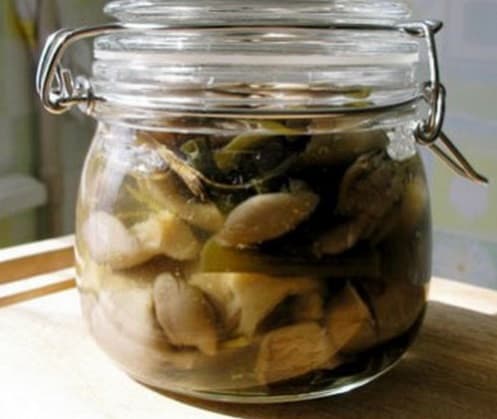

- After soaking, boil the valui in salted water (for 1 liter of water, 20 grams of salt) for 30 minutes.
- Preparing the leaven. To do this, dissolve salt, sugar, whey or kefir in boiled water, mix well.
- The next stage is laying out the mushrooms in a prepared container.
- Fill the stacked bitters with sourdough, set the oppression. We remove the container in a storage place with a temperature of 5 - 10 degrees. This temperature is favorable for the fermentation process.
- After about a day, we remove the container to a cooler place (0-4 degrees) for further ripening. It will take 30-40 days.
- After fermentation, the serushki must be laid out in sterilized jars, filled with boiled brine and rolled up with lids.
Is it possible to grow earrings?
To grow a grape seed, you need a mycelium, a substrate, and the appropriate conditions. All this requires investment, so mushroom growing is usually practiced as a business.
Serushki, in comparison with champignons, porcini mushrooms, edible tinder fungus or ringed cap (cockerels), are not in mass demand. Moreover, many mushroom pickers are not even familiar with this mushroom. And the bitter taste of potik, which complicates preparation, predetermined its fate - it is unprofitable for industrial cultivation. Artificial production of tracks is not developed.
When cooked properly, salushki can be a valuable nutritious meal. This is not the most popular mushroom in the rating of mushroom pickers, but, having an original taste, it invariably finds its fans. The mushroom does not need special cultivation, since it is rarely used in nutrition and other areas.
Serushki mushrooms are always called differently - seryanka, traveler, nest box, tree-leaf, milkman, bitter. Despite all the names, the mushroom is still edible and belongs to the russula family. But be sure to soak them before cooking.
Fried cereals in glass jars
Fried mushrooms are another way to preserve the harvest and at the same time save the housewife's time for cooking.
How to cook gray-haired mushrooms for the winter - step by step description:
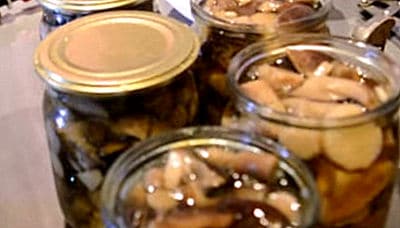

- We clean, soak, boil the grains twice.
- If the value is large, we cut it into pieces, leave the small ones intact.
- We throw it back in a colander, so that the glass is water.
- Pour oil into a deep frying pan (100 ml for each kilogram of fruit bodies) and heat up.
- After the oil has warmed up, put the mushrooms in the pan. Fry, covered with a lid, for 45 minutes, stirring constantly.
- Then we remove the lid and let the moisture evaporate.
- Next, you need to salt the serushki, mix and arrange in clean jars, pour boiling oil.
- Now you need to cover the jars with lids and sterilize for 15 minutes in a container with boiling water.
- After that, cool the container with mushrooms and store in a cool place.
After collecting
After collecting, the mushrooms must be carefully examined, rinsed and cleaned.
You can eat it only after prolonged soaking for at least three days. After that, it is necessary to cook them with a change of water, only then the bitterness will completely go away. Sometimes the bitterness can go away after 1-2 changes of water, so experienced mushroom pickers usually taste them.
It is believed that the earwort growing in coniferous forests has more bitterness than mushrooms growing in deciduous forests.
After all the procedures, the earrings can be used for pickling and frying. But during frying, it is best to mix them with other mushrooms, it will be much tastier. For example, other edible lamellar mushrooms such as russula or chanterelles are used for mixing.
The traveler is attracted by the fact that it is stored raw for a long time and is suitable for transportation. Thanks to the bitter juice in its composition, worms and rodents do not touch it, unlike other types of mushrooms.
Salting and pickling
There are two ways to pickle salted fish:
Cold way - this is when the mushrooms are stacked in jars in layers: one layer of mushrooms, the second salt. Approximately 1 tablespoon is calculated per 1 kilogram of serums. You can also add horseradish leaves, black peppercorns, dill and garlic to slightly improve the taste.
After that, you need to crush them in the bank. To do this, you need to cut a circle out of a birch forest and put it in a jar, and put a load on top. After a while, the earrings will begin to secrete juice - at this moment you need to put the leaves on top and close the lid.
The hot method is completely different... There is no need to soak the mushrooms here, they need to be boiled 2-3 times for 15-20 minutes. Each new brew should start with clean water, and after boiling, they are also tamped into jars.
Banks are placed in a cool place, for example, in a refrigerator, basement or on a balcony.It should be noted that when salted, travelers change color and become dark brown, but at the same time they are very tasty and crispy. In winter, they are useful for making salads and pies.
Serushki are unpopular with mushroom pickers, most likely due to their unsightly appearance. But those who have tried them assure that the mushrooms have an excellent taste, if, of course, they are cooked and soaked correctly.
In addition, they have high yields and are widespread. Therefore, you should not be afraid to collect and consume serushki.
How to salt gray mushrooms
The mushrooms are conditionally edible, they were assigned to the last category in terms of nutritional value due to the unexpressed taste and lack of smell. This type can only be salted, you can cook the first course, but there will be no mushroom taste. Frying fruit bodies is inappropriate. If you pickle the salted mushrooms for the winter, after 2 months you will get a delicious dish that will complement any menu.
You can salt the harvested crop in wooden, enameled or glass containers. The dishes are pre-prepared. A wooden barrel or barrel is poured with hot water for a day so that the wood is saturated with moisture and the container does not leak.
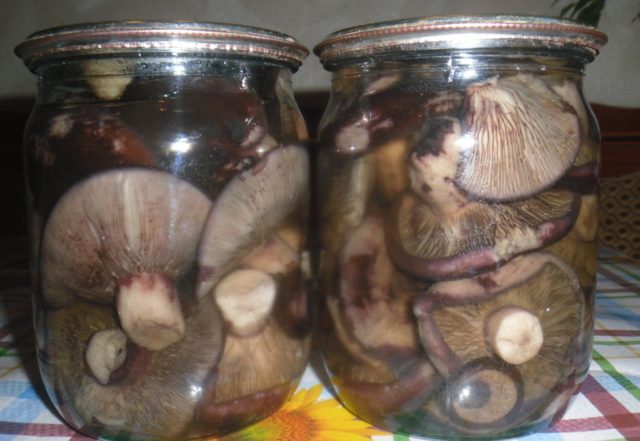

Then it is treated with boiling water with the addition of baking soda. Banks are sterilized, enameled dishes are cleaned with soda, filled to the brim with water, boiled.
A quick recipe for salting serushki mushrooms
You can salt the fruit bodies in a quick way. Processing time will take a little, and the workpiece will be usable in 25-30 days.
Over time, the brine can become cloudy and the product becomes sour. So that the fruit bodies do not lose their elasticity, and an unpleasant taste of iodine does not appear, the workpiece should be salted with ordinary rock salt.
The recipe will require:
- soaked mushrooms - 2.5 kg;
- salt - 150 g;
- cloves - 5 pcs.;
- garlic - 4 cloves;
- dill - 4 umbrellas, can be replaced with seeds;
- horseradish leaves - 2-3 pcs.
It is recommended to salt fruit bodies using the following technology:
- The bottom of the glass jar is covered with a sheet of horseradish.
- Lay the product layer tightly.
- Sprinkle on top with salt, chopped garlic, put cloves and dill.
- The next layer follows the same pattern.
- Fill the jar to the top.
- Top up with cold unboiled water.
- Cover with a sheet of horseradish from above, set oppression, cover with a napkin.
The workpiece is removed to a cool dark room for fermentation. You can use mushrooms for long-term storage, but this will require additional processing.
Classic hot salting of serushki mushrooms
Salting the mushrooms according to this recipe takes a longer time, but the preparation is stored until the next mushroom season. Hot salting of serushki provides the following ingredients (for 2 kg of raw materials):
- currant or cherry leaves - 7 pcs.;
- salt - 130 g;
- citric acid - ¼ tsp;
- garlic - 3 cloves;
- dill seeds - 1 tsp;
- allspice or black pepper - 14 peas.
You need to salt the mushrooms using the following technology:
- Boil the soaked mushrooms, put them in a colander to completely drain the liquid.
- A little salt is poured into the bottom of a sterilized glass container, a few peppercorns and dill seeds are placed.
- Serushki are poured with a layer of no more than 5 cm.
- Salt and add spices layer by layer, including garlic and currant leaves.
- The workpiece is filled with boiling water.
- Leave uncovered for a few minutes to allow air to escape completely.
Banks are covered with nylon or metal lids, removed to the basement. After 40-45 days, the product is ready. After removing the lid, the jar is stored in the refrigerator.


Cold salting of gray salted mushrooms
You can salt this species in a cold way according to the recipe for any mushrooms. Processing does not require pre-boiling. Before salt the serushki, they are soaked for at least 2-3 days, using a wooden or enamel container.
For the recipe you need spices:
- Bay leaf;
- umbrellas or dill seeds;
- horseradish leaves or root;
- peppercorns.
You need to salt, observing the sequence:
- Salt is poured into the bottom of the container.
- They put a layer of fruit bodies, sprinkle abundantly with salt, about 100 g of salt will be required per layer on an enamel pan with a volume of 50 liters or a wooden barrel.
- Spices are added.
- Fall asleep in layers to the top.
- Cover with gauze, set oppression.

